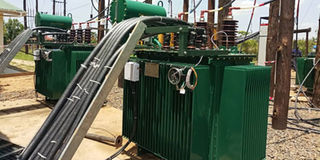When Gulu’s electricity salvation shattered

Power structures of Wenreco in West Nile. Aswa dam, whose commissioning was expected in December, according to the contractors, is expected to mitigate load shedding in Gulu District. FILE PHOTO
What you need to know:
The 42Megawatt (MW) dam is in the testing phase to date following disruptions from heavy rains at the beginning of the year, Christine Kasemiire writes
A subscriber on one of the social media channels has complained about electricity load shedding in Gulu. To quench his search for solutions, I referred him to a story published in December indicating that the electricity challenges would soon be solved by Aswa dam, whose commissioning was expected in December. He was not relieved.
Aswa dam, whose commissioning was expected in December, according to the contractors, would mitigate Gulu load shedding.
But, the 42Megawatt (MW) dam is in the testing phase to date, following disruptions caused by heavy rains at the beginning of the year.
Sources claim the dam’s power house was flooded during the heavy downpour.
Mr Kenneth Kaheru, director Aswa River Energy Project (ARPE) however downplayed the destruction saying the dam’s machines were merely affected by water and restoration is currently underway.
“Rain disrupted construction. Because of the ingestion of water, some of our machines got spoilt,” he says attributing the delay to the big size of machines which require a substantial amount of time to be cleaned to restore operations.
Aswa dam, he says, is expected to come on board by October or earlier depending on the restoration process.
The dam sitting on Achwa River, was in December seen as the salvation to Gulu’s electricity challenges. The dam’s failure was, however, seen by some as a “blessing” in disguise.
Transmission
Government, through the Uganda Electricity Transmission Company Limited (UETCL), in a Power Purchase Agreement (PPA) with ARPE committed to evacuate the electricity generated from the dam through a 132kilovotts (kV) line.
No physical sign of construction of the transmission line has been seen because of concerns raised by the financiers of the project Kfw.
“Tender documents are still being reviewed by the bank but the shortlist for engineering, procurement and construction has already been put out,” Ms Pamela Nalwanga, the manager public relations UETCL, explained adding that a notification to the shortlisted companies will follow upon approval by KfW.
However, sources in the sector claim that KfW prior to releasing funds for construction of the evacuation line, required UETCL to have completed 50 per cent of land compensation of Project Affected Persons(PAPs). The compensation was meant to display government’s commitment towards the project.
Daily Monitor, however, could not verify those claims by press time.
The energy sector is grappling with challenges in land compensation arising from high amounts demanded by PAPs, lack of land ownership documentation and abandoned land by landlords scattered in different areas, among others.
Interim solution
Upon realising that the 132kv line would be behind schedule and commissioning of the dam earlier, government in January allotted Shs30b to construct a temporary 33kv distribution line to evacuate power from Aswa dam.
“UEDCL received about Shs30b at the end of January and construction is under way,” Mr Laurn Bamanya, Uganda Electricity Distribution Company Limited (UEDCL), says.
Poles, he says, have been hoisted and manufacturing of equipment such as transformers, switch gears is ongoing by ABB – a multinational corporation in Switzerland.
Being a distribution line, only 12MW of power will be evacuated from the Aswa dam as opposed to the 42MW, meaning the dam will be operating below capacity.
Construction of the 33kv line is expected to be completed by October, in time for the dam.
Power evacuated from Aswa is to be distributed to Lira, Gulu, Kitgum and Adjumani.
Take or Pay Agreement
Like most of the PPA’s Uganda commits to with energy sector investors, the take or pay agreements entail that the country pays for electricity whether generated or not.
This means that Ugandans would pay for deemed energy (electricity output that would have otherwise been generated) by Aswa dam even if no evacuation line was present to take the power to the national grid.
UETCL signed an agreement with ARPE limited to buy power from the dam for 40 years, with a payment schedule of 9.83 US cents per Kilowatt hour in the first year.
The energy charge will later increase to 10.16 US cents/kwh in the second year and 9.97 US cents/Kwh in the third to fifteenth year.




